Disturbances
of the
bovine estrous cycle:
Anestrus

- Anestrus is considered a problem when cows are
not seen in heat.
- Failure to observe heat and heat detection must
always be ruled out as the primary problem. Review heat detection
procedures and heat detection efficiency with the producer.
- Pregnancy can be a prominent cause of anestrus
and must always be a always be a prime ruleout before anything else.
Pregnancy is often the # 1 cause of cows not being seen in heat.
- Rule out true anestrus by palpating the ovaries
'Congenital'
AnestrusFreemartin
- A freemartin is a heifer born twin to bull. 90%
are sterile
- It is caused by a chimeric condition where
hematopoetic cells intermingle in utero between the fetuses. This
results in XX and XY cells present in a freemartin.
- Partial expression of TDF (testicular
determining factor) from male Y chromosome inhibits the female
gonad.
- MIF (Müllerian inhibition factor) from the male
cells prevents Müllerian duct formation, so no uterus forms.
Clinical Signs
- These animals often have a masculine steer-like
appearance.
- They may have a small vulva and long vulvar
hairs.
- Usually the external signs of a freemartin are
noticed by the producer, so the ones you will examine as anestrus
heifers will probably have normal external signs.
Diagnosis
- The 'test tube test' checks the vaginal depth
by using a test tube.
- In normal animals you can insert a test tube
12-18 cm. In abnormal heifers the tube will only go about 7.5 cm
into the vagina. This test is only for young heifers, and age can
play a big role in how deep the vagina is.
- If they are old enough, palpation is the way to
go. These animals have no ovaries, uterus, or vagina.
- A karyotype checks for the XX and XY cell
mixture in the blood. It can be run in animals of any age, and may
be cost effective if the cost of raising the animal to maturity is
considered.
Ovarian Aplasia
- This is a rare condition when one or both
ovaries are absent.
- It is caused when the gonadal ridge does not
form correctly.
- Palpation is the best diagnostic method.
- There may be partial aplasia, when only one
ovary does not form.
Ovarian Hypoplasia
 352-353 352-353
- In ovarian hypoplasia, one or both ovaries are
smaller than normal.
- This is a recessive trait in the Swedish
Highland breed and is caused by a single autosomal recessive gene
with incomplete penetration.
- You must ruleout true anestrus.
- Again, there may be partial hypoplasia with
this condition.
Seasonal Anestrus
 403- 403-
- The is some evidence that daylight length
(photoperiod) influences fertility in Brahman breeds, but there is
no seasonal anestrus in cattle.
- Summer heat stress, when the THI (temperature
humidity index) combined effects of heat and humidity produce a high
"apparent temperature". If you compare estrus duration at
33.50 vs 18.20 C, then the estrous cycle is longer and the estrus
duration is shorter and estrus intensity is less.
- Anestrus may not really occur here, but since
estrus is harder to detect, it may appear so.
Nutritional
anestrus (Tables ) 423-427 423-427
- Nutritional anestrus in the most common problem
in beef cows. Producers often try to get by on as little feed as
possible to their cows.
- Remember the beef producers' goals is to
produce and wean as many pounds of calves each year as possible.
- Postpartum nutrition
- In the postpartum cow, lactation causes a
negative energy balance. This is even more so in first calf heifers
which are also still growing. Therefore, heifers, with the demands
of lactation, a negative energy balance and still trying to grow,
are affected most by nutritional anestrus.
- It takes cows 90 days to
attain a 60% conception rate, whereas it takes heifers 110 days.
This is primarily because the heifers are not cycling.
- By examining
these tables you can see that a cow will cycle back sooner than a
heifer and therefore become pregnant sooner after parturition.
- By feeding cows after they calve, you cannot
expect to improve the number cycling.
- Feeding pre-partum is the best
way to assure early return to cyclicity in beef cows.
- By providing
good pre-partum nutrition, you maintain adequate pre-partum condition,
so the stress of postpartum lactation produces a shorter duration of
negative energy balance.
Control
- A good method that can be used to get the
heifers cycling 'earlier', actually does not really get them cycling
earlier. What you do is breed the heifers 2-6 weeks earlier than the
cows, so they will calve earlier that the cows. If they calve
earlier, they will have longer that the cows to start cycling. If
you have a restricted breeding seasons, the heifers will be cycling
when the cows cycle.
- You can weigh the cows 100 days before calving.
The weight 24 hours after calving should be the same as that 100
days before calving. This take into account the fetus and placenta
being delivered at parturition. Obviously, this is more of a
historical finding and is not a practical preventative measure.
- Body condition scoring at weaning
- This is an ideal method to ensure adequate
prepartum nutrition. You use a system of body score condition when
the calves are weaned. (Calves are generally weaned at about 205
days postpartum, so the cows should be about 100 days pregnant.)
- The scores are :1-3: emaciated, 4 borderline,
5-7 good fat 8-9 fat.
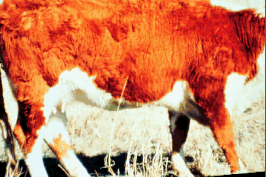 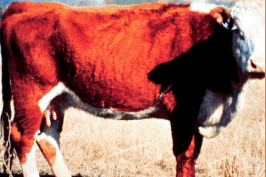
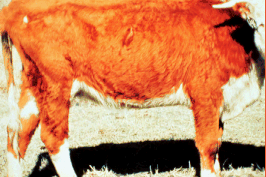 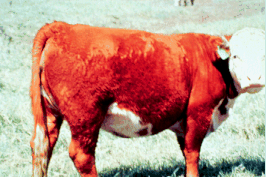
Body condition scoring. It is difficult to tell from pictures,
though.
- The goal is to have a more positive energy
balance postpartum, so if a cow is 8-9 it is too fat and does not
need supplements. A score of 5-7 is good. If cows are <4,
then extra supplementation will help them cycle earlier postpatum.
You can also wean earlier so the calves do not pull the cows down so
much, this will also result in a lower weaning weight.
Availability projection tables for -per cent conception-prepartum nutrition level (before calving)
| Mature cows Conception Rate when fed Prepartum |
| Days rest |
Low TDN |
Mod TDN |
High TDN |
| 90 |
85 |
92 |
95 |
| 80 |
80 |
90 |
95 |
| 70 |
70 |
85 |
92 |
| 60 |
47 |
80 |
90 |
| 50 |
25 |
62 |
77 |
| 40 |
25 |
45 |
65 |
| 30 |
10 |
29 |
40 |
| 20 |
10 |
12 |
15 |
Availability projection tables for
mature
cows-per cent conception-postpartum nutrition level (before breeding)
| Mature cows Conception Rate when fed Postpartum |
| Days rest |
Low TDN |
Mod TDN |
High TDN |
| 90 |
52 |
64 |
67 |
| 80 |
47 |
60 |
67 |
| 70 |
42 |
55 |
67 |
| 60 |
40 |
51 |
62 |
| 50 |
37 |
48 |
58 |
| 40 |
28 |
37 |
45 |
| 30 |
20 |
27 |
33 |
| 20 |
15 |
17 |
20 |
Availability projection tables for
first calf
heifers -per cent cycling-prepartum nutrition level (last trimester
before calving)
| heifers Conception Rate when fed Prepartum |
| Days rest |
Low TDN |
Mod TDN |
High TDN |
| 110 |
85 |
92 |
95 |
| 100 |
80 |
90 |
95 |
| 90 |
70 |
85 |
92 |
| 80 |
47 |
80 |
90 |
| 70 |
25 |
62 |
77 |
| 60 |
25 |
45 |
65 |
| 50 |
10 |
29 |
40 |
| 40 |
16 |
12 |
15 |
| 30 |
7 |
8 |
10 |
Availability projection tables for
first-calf
heifers-per cent cycling-postpartum nutrition level (after calving and
before breeding)
| Heifer Conception Rate when fed Postpartum |
| Days rest |
Low TDN |
Mod TDN |
High TDN |
| 110 |
52 |
64 |
67 |
| 100 |
47 |
60 |
67 |
| 90 |
42 |
55 |
67 |
| 80 |
40 |
51 |
62 |
| 70 |
37 |
48 |
58 |
| 60 |
28 |
37 |
45 |
| 50 |
20 |
27 |
33 |
| 40 |
15 |
17 |
20 |
| 30 |
10 |
15 |
20 |
From The Cowpedia, Syntex
Agribusiness, Inc. (IBB), 1975
TDN = total digestible nutrients
Suckling Effect of the Calf

- Suckling by the calf inhibits cyclic activity
in the cow by decreasing LH release.
- If we look at the time to
resume cycling in cows that had experimental postpartum mastectomy
(no lactation), they had the shortest interval to first heat.
- If a
cow is milked twice a day (like most dairies) she cycles back fairly
soon.
- If 1 calf is sucking, it takes a little
longer
- Four times a
day milking takes even longer
- 2 calves sucking make the longest
interval to first estrus.
-
Physical
suckling
may not
be all.
Sight
and
smell by
the dam
may be
important
too
- This suckling effect can be alleviated by early
weaning of the calf or 48 hour calf removal at start of breeding
season (called Shang Treatment).
Nutritional anestrus in dairy cattle
 416-421 416-421
- Dairy cows are usually fed well and few
problems with true anestrus. However, very high producers may be in
negative energy balance for a longer period of time and may not
cycle back as soon. This is because maximum feed intake does not
coincide with the maximum milk production.
- The average dairy cows resumes cycles 21 days
after calving.
- Some dairy heifers may be stressed or low on
the 'peck order', which causes anestrus or subestrus.
Vitamins and minerals
 420, 426
420, 426
- Vitamins and minerals are often suspected in
infertility and anestrus, especially by feed salesmen, but little
hard evidence supports these claims.
- Urea has no
effect on reproduction.
- Carotene is
needed by the CL. If it is low the cow may have low progesterone and
irregular cycles.
- Copper
requirements are 10 ppm. Less than that may cause anestrus.
- A cobalt
deficiency may cause a delayed first estrus and irregular heats.
- Mn
requirements are 40 ppm. Less than this may cause anestrus or
irregular heats.
- Phosphorus is
hard to separate from energy. It is associated with the seed portion
of plant. Cows fed at 66% NRC had no change in pregnancy rates. Cows
fed at 50% NRC for 8 months, however had lower pregnancy rates.
Experimentally low levels also delayed puberty in heifers.
Attaining puberty
- Cows need to attain a specific weight at a
specific age to attain puberty. Puberty is more weight related than
age related.
- Goals for breeding weights
Breed Target breeding weight (pounds)
Hereford 650
Angus 600
Sim X 725
Char. 700
Jersey 500
Holstein 750
- However, a report out of U.K. showed increased
economic benefit over the life of the cow by breeding at a target
age of 15 months, even if the heifers haven't reached the target
breeding weight.
Pathologic anestrus Ovarian
Atrophy
Ovarian
Atrophy
- Ovarian atrophy is caused from nutritional
problems and is most often seen in high production dairy cows.
Silent Heat
- Silent heat is generally not a problem and
usually is manifested by unobserved heats by producer. However, the
first postpartum heat is normally silent, because there are no
estrogen receptors. This is a result of the low postpartum
progesterone. Since the progesterone is needed to induce the
estrogen receptors, the estrogen are receptors are absent and heat
is silent.
Delayed Ovulation
- If a cow ovulates more than 18 hours after end
of heat, then ovulation is said to be delayed. This may be diagnosed
by palpation and can be treated with GnRH. This only occurs in <
2% of cows and is more likely to be a heat detection problem.
Pyometra
- A pyometra is a uterus filled with pus that has
a closed cervix and a CL3 on the ovary. The pus prevents the normal
luteolytic mechanism from happening. This results in anestrus.
- The fluid in the uterus mimics a pregnancy, so
the cow will not return to heat.
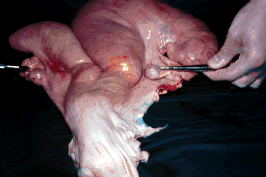
A CL3 and fluid filled horn with no positive sign of pregnancy. This
is a pyometra.
- Treatment is prostaglandin to lyse the corpus
luteum.
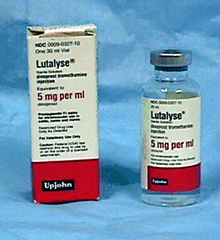
Mummy
- A mummy in the uterus will simulate a pregnancy
and prevent the normal luteolytic mechanism from happening. This
results in anestrus.
- Treatment is prostaglandin to lyse the corpus
luteum.
Uterus unicornis
- If only one uterine horn is present, because of
a Müllerian duct formation problem, and a CL forms on the
contralateral ovary, anestrus results. This persistent CL is because
of a lack of the utero-ovarian countercurrent exchange from the
uterine horn ipsilateral to the corpus luteum. This condition
actually led to the discovery of the ipsilateral counter-current
exchange mechanism.
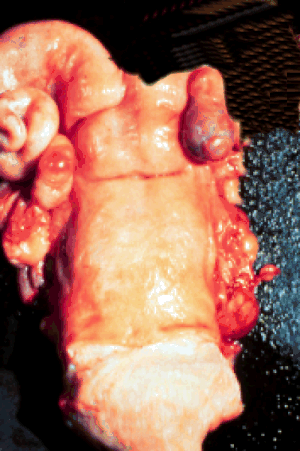
Cystic Ovarian Disease (COD), or
Follicular Cysts
 349-351 349-351

- The definition of a follicular cyst is:
- A fluid
filled structure on the ovary greater than 2.5 cm in diameter
- No CL3 present on either ovary.
- The cyst may persist for more than
10 days or regress and be replaced by another cyst.
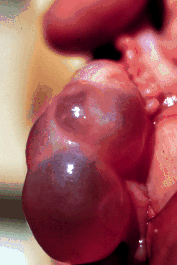 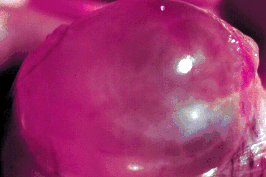
- There are actually two types of cysts,
follicular and luteal.
- A follicular cyst consists of a fluid filled
cavity (unovulated follicle) lined by a small layer of thecal cells.
The thecal cells produce progesterone, but do not have prostaglandin
receptors. If there are no prostaglandin receptors, the normal
luteolytic cascade cannot occur, resulting in anestus.
- If the granulosa cells persist in an
untransformed state (not large luteal cells), the cow will show
signs of constant estrus because of the estrogen production.
- A luteal cyst has a larger thecal (luteal
layer) that may have enough large luteal cells to respond to
exogenous prostaglandins.
- A cystic CL is just the cavity in a normal CL
that is part of the normal progression of CL development.
- Recent work has shown that there is a turnover
in follicular cysts and that they are not static structures
Clinical Signs
- Constant estrus may be seen if the granulosa
cells produce estrogen. This is not the most common sign and is
often 'diagnosed' by the producer.
- Anestrus is the most common sign. The thin
luteal layer, with no prostaglandin receptors produces enough
progesterone to prevent LH release and cause anestrus. This is the
most common sign and is the important one for a veterinarian to
diagnose the cause of anestrus.
Etiology
- The cysts are caused by a lack of LH surge. The
LH may actually be present, but may not be released. This results in
no ovulation, minimal luteinization.
- It is an hereditary disease and elimination of
bulls that have cystic daughters decreases he overall incidence in a
breed.
- Administration of estrogen in proestrus can
cause too early a release of LH, so when the cow really needs the LH
for ovulation, it is not present. Aberrant estrogens in cottonseed
meal, or possibly in poultry litter fed to cows may cause a large
number of cysts in a dairy.
- Stress may also contribute to lack of LH
release.
Treatment

- A successful treatment is considered to be a
return to a normal heat.
- If cows with cysts are not treated:
- 30%
come into heat in 0-30 days
- 39% come into heat in 30 -300 days
- 30% take over 300 days to return to heat (basically not cured).
- Why
do some cows return to heat? The small luteal cells can change into
large luteal cells with prostaglandin receptors. Now the luteolytic
cascade can take place.
|
Time after diagnosis |
Percent Recovery |
| 0-30 days |
30 |
| 30-300 days |
39 |
| >300 days (never) |
30 |
Manual rupture
- Possible side effects of manual rupture include
bleeding and adhesions.
- Manual rupture is no better than no treatment
at all and should not be considered as a treatment at all.
- I will rupture a cyst diagnostically to
differentiate it from a large, round CL.
hCG (hCG has LH actions)
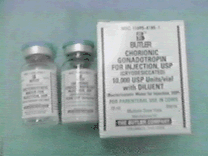
- hCG is a glycoprotein and can result in
antibody formation.
- Administration of hCG results in 80% of cows
treated in heat within 19 days, and you can expect heat in 15-30
days.
- The dose is 10,000 IU, IM; or 5000 IU, IV. Cost
and availability is becoming more of a factor. hCG comes from the
urine of pregnant women and AIDS has put a scare into its harvest.
It is still available, however.
GnRH - Cystorelin, Factrel
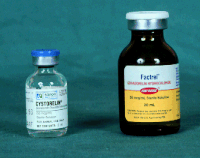
- GnRH is a decapeptide and does not cause
antibody formation.
- The dose of Cystorelin is 100 micrograms IM.
- You can expect the same treatment results as
with hCG.
- Which cows should you treat.
- As many as 50% of
all cows earlier than 50 days postpartum will have a spontaneous
regression
- Only 20% spontaneously regress if diagnosed after 50
days postpartum.
- However, it is most economically beneficial to
treat all cysts whenever they are diagnosed.
- A follow up with prostaglandin in 10-14 days
will hasten return to estrus.
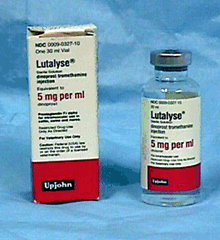
-
 OvSynch
method to treat cysts OvSynch
method to treat cysts
-
In refractory cases, progesterone can be
administered to create an artificial luteal period. The progesterone
inhibits LH release, and the abrupt progesterone withdrawal results
in an LH surge. 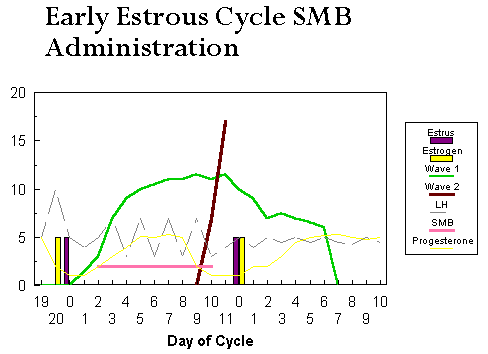 . .
|











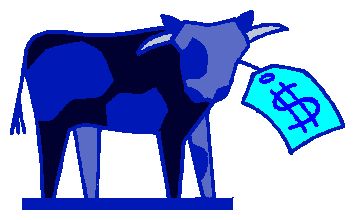 Bovine
Index
Bovine
Index
 .
.
